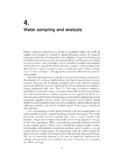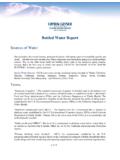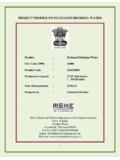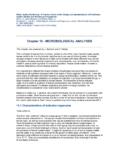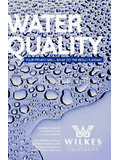Transcription of 2016 Annual Drinking Water Quality Report City of Lincolnton
1 1 2016 Annual Drinking Water Quality Report City of Lincolnton Water System Number: 0155010 We are pleased to present to you this year's Annual Drinking Water Quality Report . This Report is a snapshot of last year s Water Quality . Included are details about your source of Water , what it contains, and how it compares to standards set by regulatory agencies. Our constant goal is to provide you with a safe and dependable supply of Drinking Water . We want you to understand the efforts we make to continually improve the Water treatment process and protect our Water resources. We are committed to ensuring the Quality of your Water and to providing you with this information because informed customers are our best allies.
2 If you have any questions about this Report or concerning your Water , please contact Robert Pearson, Water Plant Superintendent at (704) 736-8970. We want our valued customers to be informed about their Water utility. What EPA Wants You to Know Drinking Water , including bottled Water , may reasonably be expected to contain at least small amounts of some contaminants. The presence of contaminants does not necessarily indicate that Water poses a health risk. More information about contaminants and potential health effects can be obtained by calling the Environmental Protection Agency's Safe Drinking Water Hotline (800-426-4791).
3 Some people may be more vulnerable to contaminants in Drinking Water than the general population. Immuno-compromised persons such as persons with cancer undergoing chemotherapy, persons who have undergone organ transplants, people with HIV/AIDS or other immune system disorders, some elderly, and infants can be particularly at risk from infections. These people should seek advice about Drinking Water from their health care providers. EPA/CDC guidelines on appropriate means to lessen the risk of infection by Cryptosporidium and other microbial contaminants are available from the Safe Drinking Water Hotline (800-426-4791).
4 If present, elevated levels of lead can cause serious health problems, especially for pregnant women and young children. Lead in Drinking Water is primarily from materials and components associated with service lines and home plumbing. The City of Lincolnton is responsible for providing high Quality Drinking Water , but cannot control the variety of materials used in plumbing components. When your Water has been sitting for several hours, you can minimize the potential for lead exposure by flushing your tap for 30 seconds to 2 minutes before using Water for Drinking or cooking. If you are concerned about lead in your Water , you may wish to have your Water tested.
5 Information on lead in Drinking Water , testing methods, and steps you can take to minimize exposure is available from the Safe Drinking Water Hotline or at The sources of Drinking Water (both tap Water and bottled Water ) include rivers, lakes, streams, ponds, reservoirs, springs, and wells. As Water travels over the surface of the land or through the ground, it dissolves naturally-occurring minerals and, in some cases, radioactive material, and can pick up substances resulting from the presence of animals or from human activity. Contaminants that may be present in source Water include microbial contaminants, such as viruses and bacteria, which may come from sewage treatment plants, septic systems, agricultural livestock operations, and wildlife; inorganic contaminants, such as salts and metals, which can be naturally-occurring or result from urban stormwater runoff, industrial or domestic wastewater discharges, oil and gas production, mining, or farming; pesticides and herbicides, which may come from a variety of sources such as agriculture, urban stormwater runoff, and residential uses.
6 Organic chemical contaminants, including synthetic and volatile organic chemicals, which are by-products of industrial processes and petroleum production, and can also come from gas stations, urban stormwater runoff, and septic systems; and radioactive contaminants, which can be naturally-occurring or be the result of oil and gas production and mining activities. In order to ensure that tap Water is safe to drink, EPA prescribes regulations which limit the amount of certain contaminants in Water provided by public Water systems. FDA regulations establish limits for contaminants in bottled Water , which must provide the same protection for public health.
7 2 When You Turn on Your Tap, Consider the Source The Water that is used by this system is surface Water which comes from the South Fork of the Catawba River. It originates in the South Mountain area in southern Burke County. Its two major headwater tributaries are Jacob Fork and Henry Fork. Our intake is located above Clark s Creek. Source Water Assessment Program (SWAP) Results The North Carolina Department of Environment and Natural Resources (DENR), Public Water Supply (PWS) Section, Source Water Assessment Program (SWAP) conducted assessments for all Drinking Water sources across North Carolina. The purpose of the assessments was to determine the susceptibility of each Drinking Water source (well or surface Water intake) to Potential Contaminant Sources (PCSs).
8 The results of the assessment are available in SWAP Assessment Reports that include maps, background information and a relative susceptibility rating of Higher, Moderate or Lower. The relative susceptibility rating of each source for the City of Lincolnton was determined by combining the contaminant rating (number and location of PCSs within the assessment area) and the inherent vulnerability rating ( , characteristics or existing conditions of the well or watershed and its delineated assessment area). The assessment findings are summarized in the table below: Susceptibility of Sources to Potential Contaminant Sources (PCSs) Source Name Susceptibility Rating SWAP Report Date South Fork River Higher July 2015 The complete SWAP Assessment Report for the City of Lincolnton may be viewed on the Web at: Note that because SWAP results and reports are periodically updated by the PWS Section, the results available on this web site may differ from the results that were available at the time this CCR was prepared.
9 If you are unable to access your SWAP Report on the web, you may mail a written request for a printed copy to: Source Water Assessment Program Report Request, 1634 Mail Service Center, Raleigh, NC 27699-1634, or email requests to Please indicate your system name, number, and provide your name, mailing address and phone number. If you have any questions about the SWAP Report please contact the Source Water Assessment staff by phone at 919-707-9098. It is important to understand that a susceptibility rating of higher does not imply poor Water Quality , only the system s potential to become contaminated by PCSs in the assessment area.
10 Water Quality Data Tables of Detected Contaminants We routinely monitor for over 150 contaminants in your Drinking Water according to Federal and State laws. The tables below list all the Drinking Water contaminants that we detected in the last round of sampling for each particular contaminant group. The presence of contaminants does not necessarily indicate that Water poses a health risk. Unless otherwise noted, the data presented in this table is from testing done January 1 through December 31, 2016 . The EPA and the State allow us to monitor for certain contaminants less than once per year because the concentrations of these contaminants are not expected to vary significantly from year to year.

